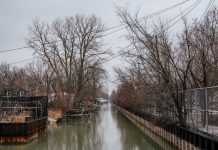It’s dwarfed by the towering RenCen hovering over it, but Mariners’ Church of Detroit on East Jefferson is a giant in its own right.
What other church can boast of escaping demolition, being moved 900 feet, and appearing in Life magazine? It also provided refuge for slaves on their way to freedom in Canada, won a landmark case against the Episcopal Diocese of Michigan, and gained fame in a hit 1976 song.
Since opening its doors in 1849, the limestone structure, which was founded to minister to Great Lakes sailors, has charted its own independent course.
In 1842, Julia Ann Anderson’s will stipulated that the site of her mansion, at Woodward and Woodbridge, be left for the construction of a mariners’ church. She further demanded that it have “free” pews. It was common practice at the time to charge parishioners for seating, and the nearly destitute sailors were relegated to the rear of churches.
Although its congregation is more diverse today, Mariners’ Church still conducts an annual Blessing of the Fleet in March and holds a Great Lakes Memorial Service each November to honor those who died on the Great Lakes, as well as those who perished in the armed forces. This year, it will be held at 11 a.m. on Nov. 7.
Though it follows the traditional Anglican liturgy, the church is an independent denomination, as cited in its charter. In the 1980s, when the Episcopal Church claimed that Mariners’ was under its domain, Mariners’ fought — and won — the suit, which was settled in the ’90s.
Mariners’ is no ordinary church — and neither is its rector, the Rev. Richard W. Ingalls Jr. The affable 62-year-old, who’s been rector since 2006 and a member of the congregation since 1965, practiced law for nearly 25 years. Before that, he was a Russian linguist in the U.S. Army Security Agency.
It was his father, the Rev. Richard W. Ingalls Sr., who tolled the church’s bell 29 times 35 years ago on the morning of Nov. 11, 1975, for each man lost on the freighter S.S. Edmund Fitzgerald, which sank in Lake Superior during a storm the previous night. The practice continued until 2006, which was also when Ingalls Sr., who was later made a bishop, died.
The sinking is still remembered as part of the broader Great Lakes Memorial Service. In 1976, Canadian troubadour Gordon Lightfoot released the ballad The Wreck of the Edmund Fitzgerald, whose lyrics include: In a musty old hall in Detroit they prayed/In the Maritime Sailors’ Cathedral/The church bell chimed ’til it rang 29 times/For each man on the Edmund Fitzgerald.
At the memorial service on Nov. 7, the 35th anniversary of the Fitzgerald tragedy will be acknowledged with a performance of Lightfoot’s song, along with a special prayer for the men who perished.
On the 10th anniversary of the sinking, Lightfoot himself attended the memorial at Mariners’ Church, an event Ingalls remembers well.
“He didn’t want [the occasion] to be about him, so we took him up a back stairway,” Ingalls says. “We put him in a front pew with his back to the congregation, so they didn’t know who he was.
“We always had a choir member perform the ballad, but when it came time for it, Lightfoot slipped out of his pew, sat on a stool, picked up his acoustic guitar, and played. First, there was a gasp, but after that, you could hear a pin drop.”
On that occasion, Ingalls says that Lightfoot turned to the congregation and announced he would henceforth change the lyrics.
Recalls Ingalls: “He said, ‘I made a mistake referring to this as a musty old hall, but I had never been here before. There’s nothing musty about this place. It’s beautiful. From now on in concert, I’m going to sing rustic old hall instead.’”
Ingalls says Lightfoot has visited the church twice since then and has remained in touch with the rector.
“When my dad died, he called me at home. He had just lost his father, and we had a nice chat,” Ingalls says. “He’s just a very thoughtful guy.”
Twenty years before the Fitzgerald sinking, Mariners’ Church itself was in danger. To accommodate the new Detroit Civic Center, aging buildings in the old wharf district were targeted for razing. However, one of the church’s trustees, George W. Stark, was a popular writer at The Detroit News and used his column as a platform to save the edifice, even suggesting the church be moved.
“He appealed to people to send in their $5 or $10, and it took off like wildfire,” Ingalls says. “There were thousands of individuals, corporations, and politicians who got behind it.”
The church was moved, ever so glacially, 900 feet east to its present location near the entrance of the Detroit-Windsor Tunnel. During the excavation, a bricked-up tunnel was discovered in the basement.
“Runaway slaves would go through that tunnel and, under the cover of night, were picked up by rowboats, which took them to Canada — and to safety,” Ingalls says.
At the time, the move of the 6-million-pound church was chronicled by Life magazine in its April 25, 1955, issue. Stark’s fundraising appeal was so successful that there was money remaining for stained-glass windows and a new bell tower.
While Ingalls takes his visitor through a tour of the church and its adjoining offices, a nautical theme clearly emerges. There are ships’ bells, anchors, and a large collection of marine paintings by Detroit painter Robert Hopkin (1832-1909).
But most striking is a jewel-toned rose window in the shape of a sailor’s compass, a symbol, perhaps, that guides Mariners’ Church through stormy and calm seas alike.
Photographs courtesy of Mariners’ Church of Detroit Archives
|
|
|
















